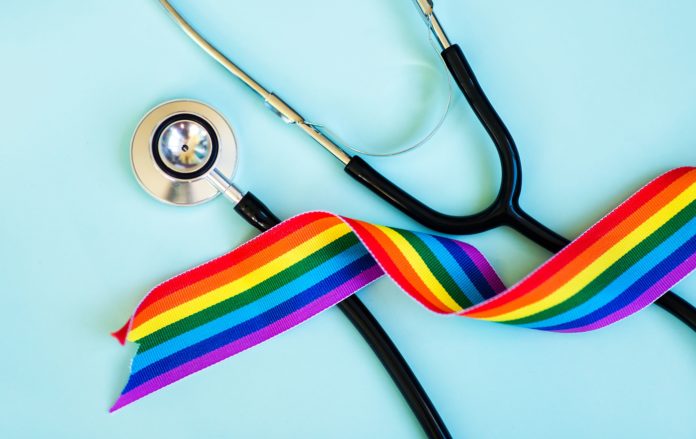
“Even with the Affordable Care Act, LGBTQ patients are more likely to be uninsured, live with the burden of chronic disease, have difficulties accessing healthcare, and be more at risk for certain types of health issues such as obesity, cardiovascular disease, and cancer,” says Jesse Ehrenfeld, MD, MPH, the first openly gay person elected to the American Medical Association (AMA) Board of Trustees.
Establishing an LGBTQ-friendly practice is the first step toward building loyalty and trust, says Ehrenfeld. Once patients are engaged, they’re more likely to have positive outcomes that ultimately reduce costs, he adds.
Consider these seven tips to create an LGBTQ-friendly practice:
1. Start small, don’t strive for perfection.
“I think most physicians have good intentions, but they let their fear of saying the wrong thing prevent them from saying anything at all,” says Clare Madrigal, BSN, RN, LGBTQ health trainer and consultant at REACH Rainbow Education and Consulting for Health, LLC.
Ehrenfeld agrees. “Patients don’t expect their physicians or healthcare teams to be perfect,” he says. “It’s ok to acknowledge that you don’t understand all of the nuances or details.”
There are plenty of resources to help physicians get up to speed with healthcare concerns in the LGBTQ population. For example, the Gay & Lesbian Alliance Against Defamation provides a helpful guide to help physicians and others talk about LGBT people using correct terminology. Physicians can also engage in more formal training. The National LGBT Health Education Center at the Fenway Institute, for example, provides an extensive library of webinars and publications. It also provides a guide for healthcare staff that includes information on how to communicate with LGBT patients, maintain a nonjudgmental attitude, avoid asking unnecessary questions, and more. GLMA: Health Professionals Advancing LGBTQ Equality provides a cultural competence webinar series that explores health concerns for LGBTQ people. The AMA also provides various resources to assist with LGBTQ population care.
Sometimes providing in-person trainings can be highly effective in terms of raising awareness and dispelling myths, says Madrigal who consults with practices in a variety of specialties to provide education on how to be more inclusive of LGBTQ patients.
2. Collect information about sexual orientation and gender identity (SOGI).
This data is critical for complying with health recommendations published by the Centers for Disease Control and Prevention (CDC), says Ehrenfeld. For example, African American men who have sex with other men are at increased risk of acquiring HIV, and the CDC recommends HIV screening and the use of pre-exposure prophylaxis. “Physicians wouldn’t even know to do these things unless they ask patients about their sexual orientation,” he adds.
Some physicians make the mistake of waiting for patients to volunteer SOGI-related information instead of asking directly for it, says Madrigal. This approach doesn’t work because patients may not willingly offer the information unless asked. They may not think it’s relevant, or they may not even know how to bring it up, she adds.
The onus is always on physicians to open the doors for these and any other health-related conversations in a nonjudgmental environment, agrees Scott Nass, MD MPA FAAFP AAHIVS, president of GLMA. “Patients are always hiding things from doctors whether it’s a diabetic who didn’t eat the right foods or someone who didn’t take their blood pressure medication,” he says. “Don’t make this one more thing that patients need to hide.”
Not sure where to start with asking SOGI-related questions? Madrigal points physicians to Do Ask, Do Tell: A Toolkit for Collecting Data on SOGI in Clinical Settings that includes information on how to ask questions and use the data.
Although most major electronic health records (EHR) include SOGI data fields, not all systems do, says Joshua D. Safer, MD, FACP, FACE, executive director of the Center for Transgender Medicine and Surgery at Mount Sinai Health System and author of Care of the Transgender Patient that was recently published in the Annals of Internal Medicine. Physicians may be able to work with their vendor to create SOGI data fields, or they can make these fields a requirement when upgrading their EHR or searching for a new EHR, he adds.
In the absence of SOGI data fields, physicians may also be able to use the FYI field to capture this data, says Madrigal. They should also include SOGI data in their notes, she adds.
Something else to keep in mind when collecting SOGI data: The EHR must be able to provide the correct screening prompts, says Safer. For example, transgender males (assigned female at birth) are still at risk for cervical cancer and require a pap smear. Likewise, transgender females are at risk for prostate cancer even when they’ve had a vaginoplasty because this surgery doesn’t typically include removal of the prostate. Most major EHRs are programmed to provide screening reminders based on sex assigned at birth rather than gender identity and expression, he adds.
3. Don’t automatically refer transgender patients to a specialist.
Internists should be able to treat the majority of health concerns for LGBT individuals and consult specialists, as needed, says Safer.
He provides the example of a patient with thyroid disease who requires thyroid medication. “Checking patients’ labs is something any internist can do,” he says. The same is true for treating transgender patients starting a hormone regimen. “You don’t need to automatically know everything. You can send them to a specialist the moment you need support,” he adds.
4. Use an inclusive intake form.
This includes asking for sex assigned at birth, chosen name, name on health insurance, and pronoun, says Alex S. Keuroghlian, MD, MPH, director of the National LGBT Health Education Center at the Fenway Institute.
The National LGBT Health Education Center provides a policy brief titled, Focus on Forms and Policy: Creating an Inclusive Environment for LGBT Patients that can help physicians develop intake forms using recommended language. For example, for sexual orientation, the National LGBT Health Education Center suggests providing these options: Straight or heterosexual; lesbian, gay, or homosexual; bisexual; something else; don’t know; choose not to disclose. Another example: Instead of using ‘husband/wife,’ use ‘spouse/partner(s).’
GLMA also provides a helpful resource that includes sample recommended questions for LGBTQ-sensitive intake forms.
In general, try to avoid questions with binary answers, says Madrigal. For example, instead of asking patients whether they have sex with men or women, ask them to describe their sexual partner(s). This provides patients the freedom to identify that they have sex with both men and women and/or transgender individuals, she adds.
Ensure that front-office staff review intake forms before addressing patients directly so they use the patient’s preferred name and pronoun, says Nass.
5. Include visual cues.
For example, Ehrenfeld says to include the following subtle cues in the waiting area or in exam rooms:
- LGBTQ magazines
- Educational brochures about LGBTQ health risks
- Posters from nonprofit LGBTQ or HIV/AIDS organizations
- Nondiscrimination statement that includes sexual orientation, gender identity, and gender expression (see the AMA’s example)
Even a practice’s website can provide subtle cues to let LGBTQ patients know they’re welcome. For example, try to avoid using too many stock photos of nuclear families, says Nass. Instead, use photos that portray same-sex couples. “People will see what they want to see,” he adds. “Maybe it’s two friends out for the day on a bike ride or maybe it’s a lesbian couple enjoying some quiet time together. Don’t be afraid to let people interpret.”
Most importantly, physicians shouldn’t worry that being LGBTQ inclusive will offend some patients, says Madrigal. “The majority of people find it to be affirming and positive. There are so many allies that also appreciate these cues,” she adds.
6. Hire the right staff.
This includes LGBTQ people and allies, says Madrigal. If a staff member doesn’t support the LGBTQ-inclusive initiative, physicians and practice managers shouldn’t feel badly about finding a replacement. “It becomes an HR issues in terms of not meeting the values of the practice,” she adds.
7. Give special attention to LGBTQ elders.
Many LGBTQ elders came of age when homosexuality was criminalized, and many faced pervasive societal discrimination, says Keuroghlian. “Understanding this historical context is critical for physicians to provide trauma-informed and affirming care,” he adds.
Working with elder patients who identify as LGBTQ often requires open and honest conversations about end-of-life issues, says Ehrenfeld.
“I think many physicians are reluctant to have these conversations in general, and they can be particular challenging to have with LGBT patients,” he says. “There are generational differences in terms of how elders identify and express who they are.” Consider a patient is not married, but who has had a same-sex partner for 30 years. The patient’s legal next of kin may not understand their wishes, and it’s important to include their partner in these conversations. If physicians don’t create a welcoming environment, patients may be reluctant to engage in these types of conversations, he adds.








